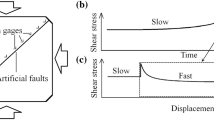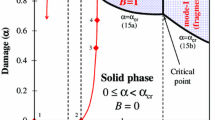Summary
A scale independent failure theory governing the initiation and subsequent growth of the shear fault in rock is presented in this article. Four distinct phases of behavior in this theory are shown to precede fault growth in rock. 1)Dilatant Phase: Cracks form in the rock in response to the applied stresses. This phase begins at a maximum principal stress whose magnitude is usually well below the ultimate strength of the rock. 2)Inclusion Phase: Clusters of cracks develop in the rock at a point in time when the rock is within a few per cent of its ultimate strength. The clusters behave physically as low modulus elastic inclusions embedded within a host material of higher modulus. As a result of this ‘elastic’ contrast, there is a rotation of the principal stress axes and a decrease in the magnitude of the principal stress difference in the focal region of the inclusion; that is, the region into which the inclusion will grow at failure. 3)Closure Phase: In this phase, there is closure of cracks in the focal region in response to the decrease in the magnitude of the principal stress difference due to the formation of the inclusion. As a result of crack closure in the focal region, the stress concentration in the focal region increases and becomes a maximum once all cracks which opened during the dilatant phase are closed. At this time, the transverse tensile stress in the interior of the inclusion also reaches a maximum. Macrocrack growth within the inclusion begins. 4)Growth Phase: Fault growth commences during this phase. Reopening of previously closed cracks occurs due to the increase in the principal stress difference in the focal region resulting from macrocrack growth within the inclusion. New cracks form and rapid growth of the macrocrack (in its own plane) occurs once the length of the mecrocrack exceeds a critical value. The fault represents the portion of the macrocrack which has closed.
Similar content being viewed by others
References
L. Obert andW. I. Duvall,Rock Mechanics and the Design of Structures in Rock (John Wiley and Sons, New York 1968), 650 pp.
M. Wyss andP. Molnar,Source parameters of intermediate and deep-focus earthquakes in the Tonga arc, Phys. Earth Planet. Interiors6 (1972), 279–292.
W. F. Brace, B. W. Paulding andC. Scholz,Dilatancy in the fracture of crystalline rocks, J. Geophys, Res.71 (1966), 3939–3953.
J. T. Cherry andJ. C. Savage,Rock dilatancy and strain accumulation near Parkfield, California, Bull. Seism. Soc. Am.62 (1972), 1343–1347.
C. H. Scholz, L. R. Sykes andY. P. Aggarwal,The physical basis for earthquake prediction, Science181, No. 4102 (1973), 803–810.
A. M. Semenov,Variations in the travel time of transverse and longitudinal waves before violent earthquakes, Isv. Earth Physics, No. 4, (1969), 245–248.
J. Whitcomb, J. Garmany andD. Anderson,Earthquake prediction: Variation of seismic velocities before the San Fernando earthquake, Science180 (1973), 632–635.
A. Nur,Dilatancy, pore fluids and premonitory variations of t s/tp travel times, Bull. Seim. Soc. Am.62 (1972), 1217–1222.
C. H. Scholz andR. Kranz,Notes on dilatancy recovery, Jour. Geophys. Res.79, No. 14 (1974), 2132–2136.
W. R. Wawersik andW. F. Brace,Post-failure behavior of a granite and diabase, Rock Mechanics3, No. 2 (1971).
W. S. Brown, S. R. Swandon andW. R. Wawersik,Further Studies of Dynamic and Biaxial Loading of Rock, Final Report, University of Utah Mechanical Engineering Department, Contract #DASA 01-71-C-0017, 99 pp., 1972.
B. T. Brady,A mechanical equation of state for brittle rock, Part I, International J. Rock Mech. Min. Sci.7 (1970), 385–421; Part II, International J. Rock Mech. Min. Sci.10 (1973a), 291–309.
W. S. Brown andS. R. Swandon,Influence of Load Path and State of Stress on Failure Strength and Stress-Strain Properties of Rocks, Technical Report No. AFWL-TR-70-53, Kirtland Air Force Base, New Mexico, 1971.
L. H. Donnell,Stress Concentrations Due to Elliptical Discontinuities in Plates Under Edge Forces, Theodore V. Karman Anniversary Volume, California Institute of Technology, Pasadena Calif., pp. 293–309, 1941.
J. C. Jaeger,Elasticity, Fracture and Flow (2nd ed.) (John Wiley and Sons, New York 1962).
B. T. Brady, W. I. Duvall andF. G. Horino,An experimental determination of the true, uniaxial stress-strain behavior of brittle rock, Rock Mechanics5 (1973b), 107–120.
B. T. Brady,Seismic precursors prior to rock failures in underground mines, Nature (1974), in press.
Author information
Authors and Affiliations
Rights and permissions
About this article
Cite this article
Brady, B.T. Theory of earthquakes. PAGEOPH 112, 701–725 (1974). https://doi.org/10.1007/BF00876809
Received:
Issue Date:
DOI: https://doi.org/10.1007/BF00876809




